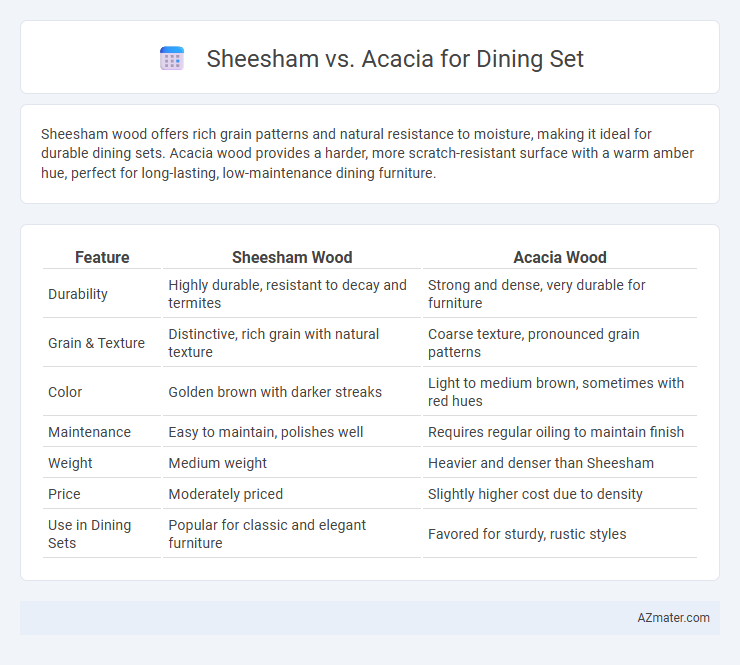Sheesham wood offers rich grain patterns and natural resistance to moisture, making it ideal for durable dining sets. Acacia wood provides a harder, more scratch-resistant surface with a warm amber hue, perfect for long-lasting, low-maintenance dining furniture.
Table of Comparison
| Feature | Sheesham Wood | Acacia Wood |
|---|---|---|
| Durability | Highly durable, resistant to decay and termites | Strong and dense, very durable for furniture |
| Grain & Texture | Distinctive, rich grain with natural texture | Coarse texture, pronounced grain patterns |
| Color | Golden brown with darker streaks | Light to medium brown, sometimes with red hues |
| Maintenance | Easy to maintain, polishes well | Requires regular oiling to maintain finish |
| Weight | Medium weight | Heavier and denser than Sheesham |
| Price | Moderately priced | Slightly higher cost due to density |
| Use in Dining Sets | Popular for classic and elegant furniture | Favored for sturdy, rustic styles |
Sheesham vs Acacia: An Overview
Sheesham and Acacia are both popular hardwoods known for their durability and aesthetic appeal in dining sets. Sheesham, also called Indian Rosewood, features a rich, dark grain with natural oils that resist decay, making it highly durable and low-maintenance. Acacia offers a lighter, golden hue with a smooth finish, prized for its strength and resistance to scratches and water, ideal for family dining sets requiring longevity and style.
Wood Grain and Color Differences
Sheesham wood features a rich, dark brown color with prominent, natural grain patterns that add a warm, rustic charm to dining sets, while Acacia wood typically displays a lighter, golden to reddish hue with a more uniform and smoother grain texture, offering a contemporary and elegant look. The contrasting grain of Sheesham provides a bold, organic aesthetic that highlights the wood's natural imperfections, whereas Acacia's finer grain appeals to those seeking a cleaner, more polished finish. Color variations in Sheesham can range from deep chocolate browns to honey tones, whereas Acacia maintains a consistent color palette that enhances its durability and resistance to wear.
Durability and Longevity Comparison
Sheesham wood, known for its dense grain and natural oils, offers superior resistance to moisture and termites, ensuring exceptional durability for dining sets. Acacia wood provides strong hardness and dense fibers, making it resilient against scratches and impacts, but generally requires regular maintenance to preserve its longevity. Overall, Sheesham tends to outperform Acacia in long-term durability due to its natural protective properties and lower susceptibility to environmental damage.
Maintenance Requirements
Sheesham wood dining sets require regular oiling and polishing to maintain their natural grain and prevent cracking or drying, making them moderately high-maintenance. Acacia wood dining sets offer greater durability with a natural resistance to stains and moisture, requiring less frequent upkeep such as occasional cleaning and re-oiling to preserve their finish. Both woods benefit from avoiding excessive exposure to sunlight and humidity to extend the lifespan of the dining set.
Resistance to Pests and Moisture
Sheesham wood offers strong natural resistance to pests due to its dense grain and natural oils, making it a durable choice for dining sets in areas prone to insect activity. Acacia wood also provides good pest resistance but is particularly known for its superior moisture resistance, which helps prevent warping and swelling in humid environments. Choosing Sheesham favors pest durability, while Acacia excels in moisture resistance, making each wood type suited for different environmental challenges in dining furniture.
Sustainability and Eco-Friendliness
Sheesham wood, sourced from Dalbergia trees, is known for its durability and sustainability due to its fast growth and minimal chemical treatment, making it an eco-friendly choice for dining sets. Acacia wood, harvested from fast-growing, renewable species, exhibits high resistance to decay and requires less maintenance, contributing to its environmental benefits. Both woods provide sustainable options, but Sheesham's natural oils reduce the need for pollutants, enhancing its eco-friendly profile in furniture production.
Cost and Affordability Analysis
Sheesham wood-based dining sets generally cost more than Acacia due to Sheesham's dense grain and natural resistance to pests, making it a premium choice in furniture markets. Acacia dining sets offer a more budget-friendly option while providing durability and a pleasant finish, appealing to cost-conscious buyers seeking value without compromising quality. Affordability trends show that Acacia wood's faster growth cycle contributes to lower prices, whereas Sheesham's slower growth and scarcity drive higher costs, impacting long-term investment decisions for dining room furniture.
Design Versatility and Finishing Options
Sheesham wood offers rich grain patterns and natural hues that enhance design versatility, allowing for intricate carvings and a rustic or traditional dining set aesthetic. Acacia wood provides a smoother surface with a variety of finishing options, ranging from matte to polished, making it ideal for modern or contemporary dining room designs. Both woods accommodate diverse styles, but Sheesham excels in handcrafted detailing while Acacia supports sleek, minimalist finishes.
Popular Uses in Dining Furniture
Sheesham wood, prized for its rich grain and natural durability, is widely used in dining sets due to its elegant finish and resistance to wear, making it ideal for long-lasting furniture. Acacia wood, known for its dense and hard properties, offers robust structure and moisture resistance, commonly preferred for rustic and contemporary dining tables. Both woods are favored in dining furniture manufacturing for their strength and aesthetic appeal, with Sheesham standing out in traditional designs and Acacia excelling in modern, versatile dining environments.
Which Wood Is Best for Your Dining Set?
Sheesham wood, known for its rich grain patterns and natural durability, offers excellent resistance to scratches and moisture, making it ideal for long-lasting dining sets. Acacia wood is prized for its toughness, dense texture, and resistance to wear and tear, providing a robust and sturdy dining experience. Choosing between Sheesham and Acacia depends on desired aesthetics and durability, with Sheesham offering a more polished look and Acacia prioritizing strength for heavy use.

Infographic: Sheesham vs Acacia for Dining Set
 azmater.com
azmater.com